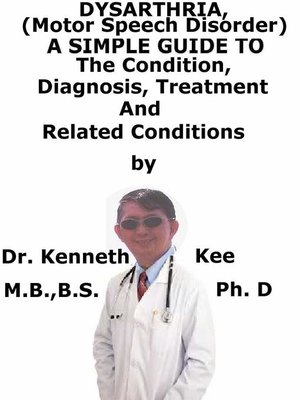Dysarthria, (Motor Speech Disorder) a Simple Guide to the Condition, Diagnosis, Treatment and Related Conditions
ebook
By Kenneth Kee

Sign up to save your library
With an OverDrive account, you can save your favorite libraries for at-a-glance information about availability. Find out more about OverDrive accounts.
Find this title in Libby, the library reading app by OverDrive.



Search for a digital library with this title
Title found at these libraries:
| Library Name | Distance |
|---|---|
| Loading... |
Dysarthria is a motor speech disorder in which the patient finds difficulty saying words because of disorders with the muscles that assist the patient to talk.Dysarthria occurs from impaired movement of the muscles utilized for speech production, such as the lips, tongue, vocal folds, and diaphragm.The type and severity of dysarthria are dependent on which area of the nervous system is involved.The muscles used for speech are managed by the brain and nervous system.Dysarthria can form if either of these is injured in some way.Dysarthria can either be:1. DevelopmentalIt happens as a result of brain damage before or during birth, such as in cerebral palsy2. AcquiredIt happens as the result of brain changes later in life, such as damage caused by a stroke, head injury or brain tumor, or a progressive disorder such as Parkinson's diseaseDysarthria in children is normally developmental while dysarthria in adults is often acquired, even though both types can affect people of any age.Symptoms:A person with dysarthria may show the following speech characteristics:1. "Slurred," "choppy," or "mumbled" speech that may be difficult to understand2. Slow rate of speech3. Rapid rate of speech with a "mumbling" quality4. Limited tongue, lip, and jaw movement5. Abnormal pitch and rhythm when speaking6. Changes in voice quality, such as hoarse or breathless voice or speech that sounds "nasal" or "stuffy"Diagnosis:Family and friends may be required to help with the medical history.An intervention called laryngoscopy to see the voice box clearly may be done.During this procedure, a flexible viewing scope is inserted into the mouth and throat to view the voice box.Tests that may be done if the cause of the dysarthria is not known are:1. Blood tests for toxins or vitamin levels2. Imaging tests, such as an MRI or CT scan of the brain or neck3. Nerve conduction studies and electromyogram to check the electrical function of the nerves or muscles4. Swallowing study, which may include x-rays and drinking a special liquidThe speech therapist may also want to evaluate the movement of the muscles in the mouth and voice box (larynx), and may wish to make a recording of the voice.TreatmentThe patient may need to be referred to a speech and language therapist for testing and treatment.Special skills the patient may learn are:1. Safe chewing or swallowing techniques, if required2. To avoid conversations when the patient are tired3. To repeat sounds over and over again so the patient can learn mouth movements4. To speak slowly, use a louder voice, and pause to make sure other people understand5. What to do when the patient feel frustrated while speakingThe patient can use many different devices or techniques to help with speech, such as:1. Apps that use photos or speech2. Computers or cell phones to type out words3. Flip cards with words or symbolsSurgery may help people with dysarthria.A speech and language therapist will work as part of a healthcare team that has people from the health, social and voluntary sector.The therapist will try to improve and increase the patient or the child's ability to talk.They will help the patient find different methods of communicating, and will help the patient and the family in adjusting to the new situation.They may advise:1. Strategies to improve speech, such as slowing speech down2. Exercises to enhance the volume or clarity of speech3. Assistive devices, such as a simple alphabet board, an amplifier, or a computerized voice output systemTypes of Dysarthria1. Spastic2. Flaccid3. Ataxic4. Hyperkinetic and hypokinetic5. Mixed dysarthriaTABLE OF CONTENTIntroductionChapter 1 DysarthriaChapter 2 CausesChapter 3 SymptomsChapter 4 DiagnosisChapter 5 TreatmentChapter 6...







